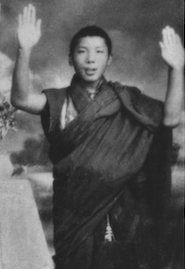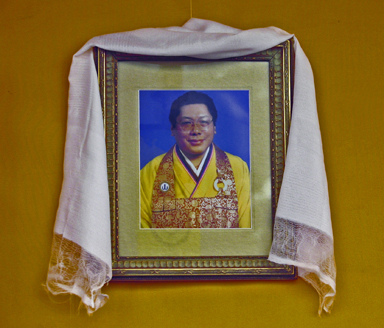In 1970, a Tibetan Buddhist Lama who once endured extreme thirst rather than drink fermented spirits came to America. Chogyam Trungpa never turned down a drink again. His defying the conventions of ancient tradition did not stop there. He was far from a typical spiritual leader. He discarded the orange and brown robes of a Lama in favor of Western business suits, preferred steak to vegetarian fare, smoked and drank alcohol. These changes made him more accessible in the American culture of the 1970s. He became a modern guru at the vanguard of Western Buddhism.

Born in Tibet in 1939 he was recognized as the reincarnation of the 10th Trungpa while still a toddler. He learned a thousands years of Tibetan knowledge before the Chinese invaded in 1959. The devout Buddhist suffered months of deprivation crossing the southern reaches of the Himalayas to reach northern India and safety. From there he went to England where he first encountered, and immersed him self in Western culture.
In 1970 his students from Scotland opened Tail of the Tiger, the first Tibetan Buddhist center in America on land they purchased in Vermont. Later that year Trungpa began teaching at the University of Colorado. More centers opened in Boulder and across the country. A meeting with Zen Master Shunryu Suzuki that year showed him that by initially teaching meditation to his students they were more likely to accept his message. The Dharma lessons and disciplines could follow later.
Trungpa was an irascible teacher.
“Wake them up” was his motto. Insult their ego, strip away vanity, and assault their idea of self to open their minds. It was not through chanting mantras, donning robes, or avoiding pleasures that people would find happiness. One only had to find their basic goodness or buddha-nature. They only had to allow it to manifest.
Radical change of Teaching
There was a radical change to Trungpa’s teaching methods in 1974. The 16th Karmapa came to visit the boy he had recognized as the 11th Trungpa nearly 30 years before. Chogyam saw the opportunity to return to Tibet, if only in a spiritual sense. He instructed his students in the formalities of being in the presence of such a revered holy man. Tie-dye and jeans were replaced by suits and dresses, and good china was unboxed, the silverware rubbed until it gleamed.
Informal training turned to in-depth instruction after Karmapa’s visit. The ngondro, its prostrations, recitations, visualizations and offerings to mandalas were taught to advance the knowledge of his students.
Shamballa International was founded by Chogyam Trungpa Rinpoche to spread Tibetan Buddhist culture throughout America and Canada. Its retreat facility at the Rocky Mountain Shamballa Center continues the Dharma instruction he began. The Great Stupa of the Dharmakaya Which Liberates Upon Seeing, a place of pilgrimage for American Buddhists was built there. Like Trungpa Rinpoche’s vision it is a unique melding of modern American and traditional Tibetan sensibilities.
Chogyam Trungpa’s lifestyle and methods were controversial
Sex, with students and others was a way to combat the possessive nature of Americans. Imbibing liquor continuously and in great quantities finally took its physical toll. He entered the bardo in 1986, at the age of 47.
By presenting Tibetan Buddhism using American terms and the experiences of modern life, Trungpa helped introduce an ancient teaching to a new world. It took 500 years for Buddhism to make the journey from India to Tibet. Chogyam Trungpa Rinpoche brought Tibetan Buddhism to America with every Dharma talk.





